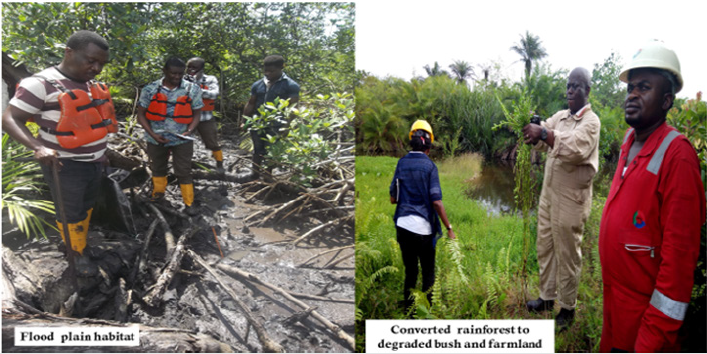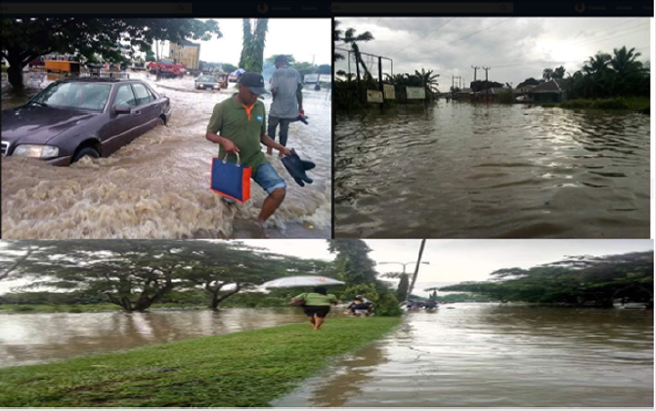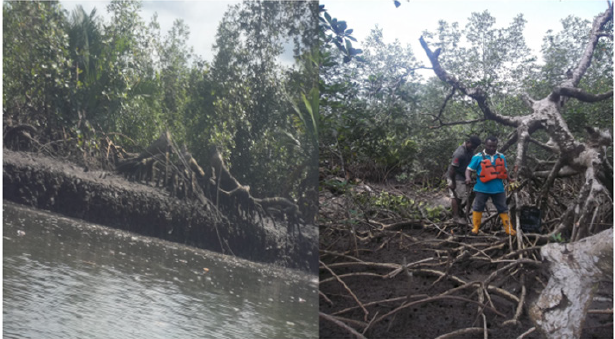
Lupine Publishers Group
Lupine Publishers
Menu
ISSN: 2641-6794
Review Article2641-6794 
Environmental Stress and Ecological Imbalance in the Niger Delta of Nigeria: Our Experiences Volume 5 - Issue 4
UdoInyang UC and Edem ID *
- Department of Soil Science and Land Resources Management,University of Uyo, Nigeria
Received: July 29, 2020; Published: August 18, 2020
Corresponding author:Edem ID,Department of Soil Science and Land Resources Management,University of Uyo, Nigeria
DOI: 10.32474/OAJESS.2020.05.000220
Abstract
When the word “environment” is mentioned, what readily comes to mind is its devastation. This is not strange because what we see around us is nothing but uncleanliness arising from human activities. What has contributed to this ugly scenario is none other than man himself. Nature naturally would always want to retain its naturalness. The forces of nature that ordinarily brings about earth quakes, landslide, flood and other natural events are but the balancing of these forces to maintain stability, but human activities have brought about artificial events, the effects of which we now call devastation and pollution. Even though, the natural forces tend to equilibrate these unnatural events arising from human activities, these are stretched beyond their limits. It is the human being who should and could assist in this direction that attempt at remediating the environment
Introduction
The improper exploration and exploitation of Nigeria’s rich
natural resources is having negative impact on the social and
economic health of the citizens, the land resource and ecosystem
integrity. While some of the northern states are being ravaged by
drought and desertification, exuberated by human activities, some
of the Southern (Niger Delta) parts were constantly threatened
by massive erosion [1].Increased incidences of flooding across
the region constitute clear evidence of stress and ecological
imbalance in the environment of many of our communities today.
The key environmental challenge is to combat land degradation,
deforestation, drought and desertification, loss of biodiversity,
flooding, erosion, urban decay and municipal waste disposal and the
adverse effects of climate change [2]. When properly managed, the
environment could catalyse sustainable growth and development.
Conversely, if poorly managed, the environment can become
hazardous and threatening human survival. But where human
interaction with the environment results in degradation, depletion
of renewable and non-renewable resources and massive pollution
Uyigue and Agbo [3], it can be a significant source of economic
loss upon human society. Therefore, environmental managers at
the National, State and the Federal levels are charged to address
these highlights and also ensure that environmental concerns were
effectively integrated into development process at sub-national
levels of government to ensure sustainability.
Contribution of Land Subsidence
Land subsidence has been reported as a possible factor contributing to flooding in the Niger Delta. Several factors, including natural geologic processes and hydrocarbon extraction, may be the cause. Land subsidence can cause: (l) Coastal flooding, (2) Coastal erosion from increased wave penetration inland, (3) Forest inundation and (4) Saltwater intrusion. The extensive oil and water extraction from subsurface layers, and the reduction in sediment input by upstream dams may have accelerated local subsidence. However, since oil extraction occurs at very deep levels (4,000 - 8,000 m below the surface) it is unlikely that subsidence from that level will be significantly manifested on the surface.
Loss of Sediment Increased Flood and Erosion
During the last 20 years, the Niger river and its tributaries have been dammed for irrigation at various locations and the water flow has been manipulated extensively. It is estimated that around 70% of the sediment transport via these rivers into the sea has been lost because of the dams. The loss of sediment input to the delta via the rivers is exacerbating coastal and riverbank erosion. ln many areas in Ibeno and Utaewa in Ikot Abasi, the erosion caused by waves, currents and other oceanic processes is estimated to range from tens of meters per year to over 100 m per year [4]. In other areas, coastal erosion is pronounced in selected areas particularly Brass, Bonny, and Sangana. Estimates of coastal erosion at Brass range from 16-19 meters annually [5]. Construction of breakwaters and jetties also caused coastal recession. For instance, at the mouth of the Escravos river, Ogborodo beach have receded by 20 m per year since breakwater construction Abam [6] Tidal erosion occurs in the Southern parts of the Delta as a result of high tides in combination with waves that had affected a number of townships and islands Figure 1.
Other factors that contribute to coastal erosion are sand and gravel mining, dredging, reclamation of land, as well as oil, gas and water abstraction and the removal of vegetation (mangrove). It is estimated that close to 400 ha of land is lost annually to riverbank erosion [1]. With the present trend, about 40% of the current inhabited land will be lost within 30 years and about 750,000 people displaced. Since riverbank levees are the most populated areas and are intensively cultivated, riverbank erosion results in loss of some of the most valuable land in the delta.
Renewable Resources Degradation
Fisheries exploitation
The preservation of the freshwater swamp and mangrove ecosystems is crucial for the viability of a large coastal and wetland fishery. Fluctuation in captures, decreasing sizes of fish, and observations from fishers give evidence of` declining stocks from over exploitation and habitat degradation [7]. The delta, being predominantly a flood plain habitat is a very productive water body for fisheries and a crucial nursery for offshore and upstream ecosystems. Habitats of particular importance for the coastal and estuarine fisheries are the mangroves and sea grasses. In locations where the oil exploration is carried out, environmental stress ranging from inappropriate sewage and waste disposal, cutting of mangroves for fuel to degraded mangroves to various degrees near most villages, towns, and cities. Damage has also occurred in the immediate surroundings of oil production sites.
Forest exploitation
The majority of mangroves, the third largest mangrove forest in the world and the largest in Africa are in the Niger Delta [8]. The activities in the Niger Delta are eliminating approximately 3.5% of the forest annually [9]. lf this rate of deforestation continues; the remaining forests of the region will be eliminated in less than 20 years. As an ecological zone, very little remains of the lowland rainforest. Only a few of the forests left are significant in size and species diversity. For example, Ogoni land used to be covered with a rainforest but has been largely converted to degraded bush and farmland Figure 2. The remaining forest stands in the lowland rainforests are contained in relic shrine forests, which may include only a few individual trees, or are managed by local communities along riverine areas. The Barrier Island Forests, the smallest of the ecozones in the Delta are freshwater forests found between the coastal beaches and the estuarine mangroves. The forests are degraded in accessible areas, but large areas of high-quality forest with high concentration of biodiversity exist. The mangroves are the least disturbed of the forest zones. Only an estimated 5-10% has been lost to urban growth, industrial development, and oil activities. ln the Freshwater and Barrier Island Forests, forest utilization is second only to agriculture as the most significant economic activity in the freshwaters wamp forest zone.
Figure 2: Ogoni land used to be covered with a rainforest but has been largely converted to degraded bush and farmland.

Infrastructure
Canal and roads are critical for improved transportation
and communication in many isolated communities in the Niger
Delta. However, their construction has precipitated some of
the most extensive environmental degradation in the region.
The greatest environmental concerns are not the canals and
roads per se, but farmers who establish new plots in the natural
forests and loggers who gain better access to the forests. As well
as agricultural and logging expansion, forest ecosystems are
degraded by professional hunters and to a lesser extent by farmers
hunting to supplement their diet and income. Requiring extensive
transportation networks, oil companies, as well as government
agencies, have greatly contributed to agricultural encroachment by
building hundreds of kilometers of roads through the freshwater
swamp forest zone. Improved transportation and selective road
construction are undoubtedly required for development in the
delta. but must recognize ecological differences and minimize its
environmental impact. Lack of Environmental Impact Assessment
(EIA) and funding, limit the quality of road construction and damage
ecosystems. In the long term, construction of adequate roads would
be less expensive than chronically rebuilding poor roads. Current
examples of environmental degradation include oil company’s
and Niger Delta Development Company’s (NDDC) roads that block
streams and flood plains creating stagnant ponds of water, killing
forests, and flooding fields.
Canal projects are also widespread in the delta especially in the
mangrove forests. Designed to improve transportation between
settlements or gain access to oil installations. The canals can have
substantial effects on water flow patterns and ecosystems. As with
roads, hunters and timber contractors follow the canals into new
areas.
Mangroves Habitat Destruction
Mangrove clearing is especially problematic because of the very slow regeneration rates. A few meter wide of Seismic lines cut over a decade ago are still visible by air. In addition to the cleared mangroves, a large number of mature Rhizophora spp (mangroves) (Figure 3) near flow stations are dead, possibly from oil clogging roots and suffocating the roots. Pipelines, flowlines, and to a lesser extent seismic lines fragment forests and open them up for better access for hunters, but unlike roads do not attract farmers in their wake. The clearance required for some of the lines can be very large: a 6-inch flowline requires that a swath of forest 5 m wide be cut. Drilling operations require the construction of slots and in some cases wider transportation canals. Dredge spoils of acid sulphate soil, because of their high acidity when dry, can decrease yields and severely disrupt natural regeneration of forest edges.
Within the delta, biological diversity is concentrated in the freshwater and barrier island ecological zones. The extreme hydrological conditions of the mangrove forests limit their biological richness. While the lowland rainforests were historically the most biologically diverse of the delta ecozones, severe deforestation has greatly reduced both the number of species and the diversity of the ecosystems [10]. The two principal threats to biodiversity are habitat destruction and hunting. Both factors are directly tied to road and canal construction, increasing access of farmers, loggers, and hunters to forests.
Pollution from Oil Activities
From extraction of oil in the Niger Delta to arrival at a terminal or
refinery, a number of potential pollution outlets from the oil stream
can be identified. The outlets can be categorized as air emissions,
water effluents, and waste generation [11]. Air emissions mainly
originate from gas flaring in relation to gas and crude oil separation.
Water effluents mainly originate from separation of production
water and oil. While waste generation mainly originates from
hazardous sludge from separation of crude oil and water; drilling
sludge; household waste, scrap and worn out equipment.
Probably no other aspect of environmental contamination has
been as carefully studied as petroleum hydrocarbon pollution,
particularly its impact on the marine environment. Obviously, oil
industry operations in the delta involve a large number of activities
that may cause environmental effects in addition to oil spills.
Conclusion
Every human being on the surface of the earth must be concerned with the happenings of our time, the earth planet, be it under the groupings of government, NGOs, civil society, legislative arm of government, the government, and in fact every individual, all have roles to play. The task is enormous and it requires the economist, the ecologists, biologist, sociologists, politicians, layers, who define social aspersions and have to plan, steer and drive through the transition from today’s growth economy to an ecologically balanced economy, where agriculture will operate more naturally without pesticides and inorganic fertilizers, factories will produce in an environmentally friendly manner. Then would the forces of nature work symbiotically with us human.
References
- Odu CT (1995) Defining an environmental strategy for the Niger Delta, Nigeria: World Bank Industry and Energy Operations Division, West Central Africa Department.
- Zabbey N (2004) Impacts of extractive industries on the biodiversity of the Niger Delta region, Nigeria. Paper presented at: National Workshop on Coastal and Marine Biodiversity Management. Sep 7-9, Calabar, Cross-River State, Nigeria.
- Uyigue E, Agbo M (2007) Coping with climate change and environmental degradation in the Niger Delta of Southern Nigeria, Benin City, Nigeria: Community Research and Development Centre.
- Abam TKS (1999) Impact of dams on the hydrology of the Niger Delta. Bull Eng Geol Environ 57: 239-251.
- Abu GO, Dike PO (2008) A study of natural attenuation processes involved in a microcosm model of a crude oil-impacted wetland sediment in the Niger Delta. Biores Technol 99: 4761-4767.
- Abam T, Okogbue C (1993) Utilization of marginal lands for construction in the Niger Delta. Bull Eng Geol Environ 48: 5-14.
- Ekeke BA, Davies OA, Alfred-Ockiya JF (2008) Sand dredging impact on fish catch in Bonny River Estuary, Nigeria. Environ Res J 2: 299-305.
- Walther GR, Post E, Convey P, Menzel A, Parmesan C, and et al. (2002) Ecological responses to recent climate change. Nature 416: 389-395.
- United Nations Environment Programme (2007) Mangroves of Western and Central Africa. In Report produced for UNEP-DEPI under the UNEP Biodiversity Related Projects in Africa, Corcoran, Ravilious CE, Skuja M (Eds.), Cambridge, UK.
- Uluocha N, Okeke I (2004) Implications of wetlands degradation for water resources management: lessons from Nigeria. Geo Journal 61: 151-154.
- Ugochukwu CNC, Ertel J (2008) Negative impacts of oil exploration on biodiversity management in the Niger Delta area of Nigeria. Impact Assess Project Appraisal 26(2): 139-147.

Top Editors
-

Mark E Smith
Bio chemistry
University of Texas Medical Branch, USA -

Lawrence A Presley
Department of Criminal Justice
Liberty University, USA -

Thomas W Miller
Department of Psychiatry
University of Kentucky, USA -

Gjumrakch Aliev
Department of Medicine
Gally International Biomedical Research & Consulting LLC, USA -

Christopher Bryant
Department of Urbanisation and Agricultural
Montreal university, USA -

Robert William Frare
Oral & Maxillofacial Pathology
New York University, USA -

Rudolph Modesto Navari
Gastroenterology and Hepatology
University of Alabama, UK -

Andrew Hague
Department of Medicine
Universities of Bradford, UK -

George Gregory Buttigieg
Maltese College of Obstetrics and Gynaecology, Europe -

Chen-Hsiung Yeh
Oncology
Circulogene Theranostics, England -
.png)
Emilio Bucio-Carrillo
Radiation Chemistry
National University of Mexico, USA -
.jpg)
Casey J Grenier
Analytical Chemistry
Wentworth Institute of Technology, USA -
Hany Atalah
Minimally Invasive Surgery
Mercer University school of Medicine, USA -

Abu-Hussein Muhamad
Pediatric Dentistry
University of Athens , Greece

The annual scholar awards from Lupine Publishers honor a selected number Read More...






